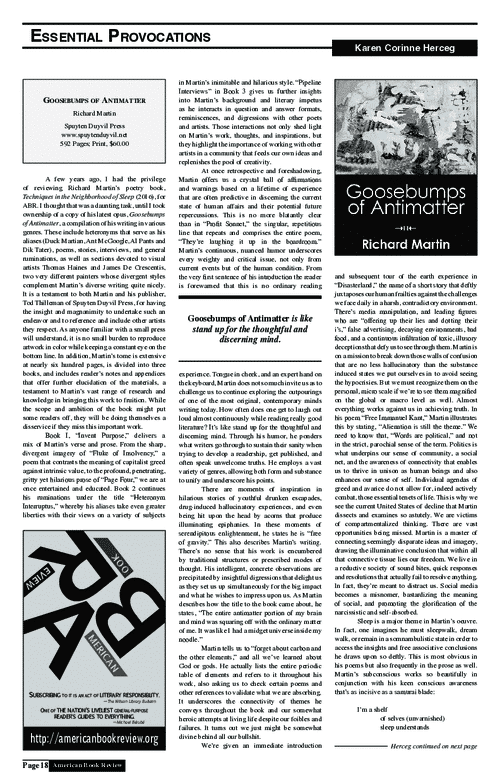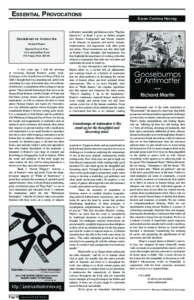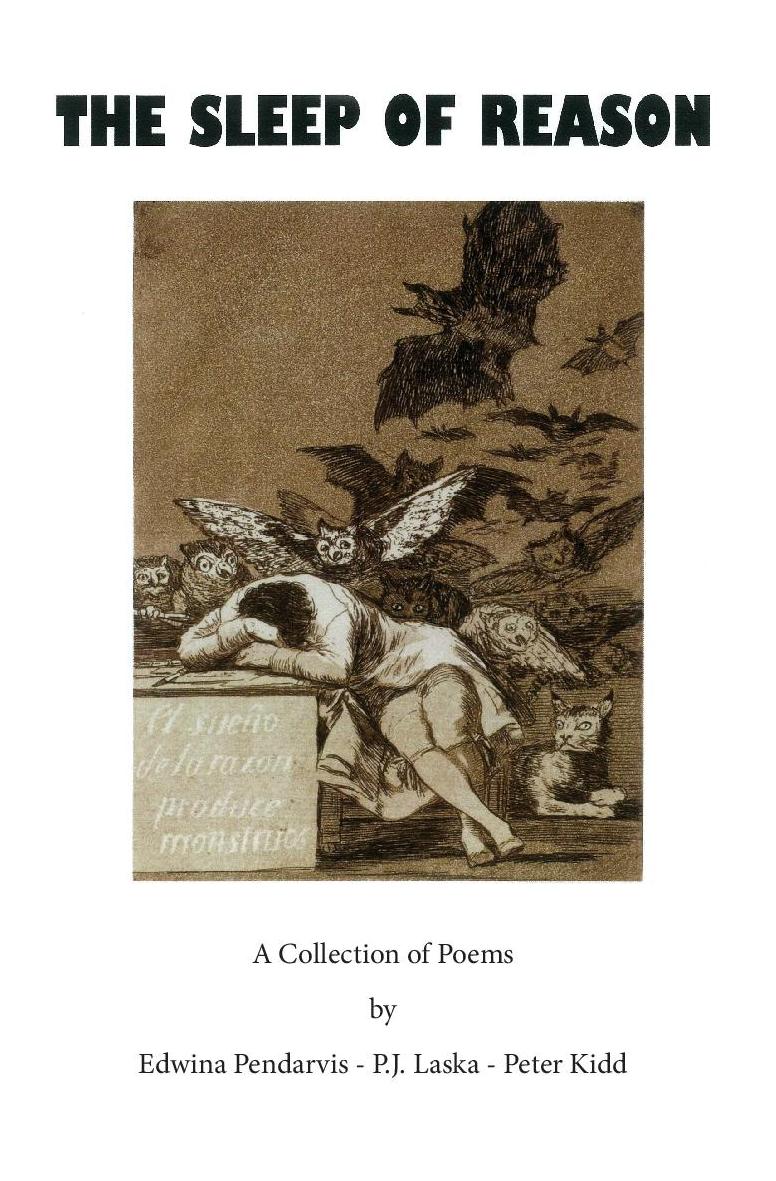

Essential Provocations
GOOSEBUMPS OF ANTIMATTER
Richard Martin
Spuyten Duyvil Press
www.spuytenduyvil.net
592 Pages; Print, $60.00
A few years ago, I had the privilege of reviewing Richard Martin’s poetry book, Techniques in the Neighborhood of Sleep (2016), for ABR. I thought that was a daunting task, until I took ownership of a copy of his latest opus, Goosebumps of Antimatter, a compilation of his writing in various genres. These include heteronyms that serve as his aliases (Duck Martian, Ant McGoogle, Al Pants and Dik Tater), poems, stories, interviews, and general ruminations, as well as sections devoted to visual artists Thomas Haines and James De Crescentis, two very different painters whose divergent styles complement Martin’s diverse writing quite nicely. It is a testament to both Martin and his publisher, Tod Thilleman of Spuyten Duyvil Press, for having the insight and magnanimity to undertake such an endeavor and to reference and include other artists they respect. As anyone familiar with a small press will understand, it is no small burden to reproduce artwork in color while keeping a constant eye on the bottom line. In addition, Martin’s tome is extensive at nearly six hundred pages, is divided into three books, and includes reader’s notes and appendices that offer further elucidation of the materials, a testament to Martin’s vast range of research and knowledge in bringing this work to fruition. While the scope and ambition of the book might put some readers off, they will be doing themselves a disservice if they miss this important work.
Book I, “Invent Purpose,” delivers a mix of Martin’s verse and prose. From the sharp, divergent imagery of “Fluke of Insolvency,” a poem that contrasts the meaning of capitalist greed against intrinsic value, to the profound, penetrating, gritty yet hilarious prose of “Page Four,” we are at once entertained and educated. Book 2 continues his ruminations under the title “Heteronym Interruptus,” whereby his aliases take even greater liberties with their views on a variety of subjects in Martin’s inimitable and hilarious style. “Pipeline Interviews” in Book 3 gives us further insights into Martin’s background and literary impetus as he interacts in question and answer formats, reminiscences, and digressions with other poets and artists. Those interactions not only shed light on Martin’s work, thoughts, and inspirations, but they highlight the importance of working with other artists in a community that feeds our own ideas and replenishes the pool of creativity.
At once retrospective and foreshadowing, Martin offers us a crystal ball of affirmations and warnings based on a lifetime of experience that are often predictive in discerning the current state of human affairs and their potential future repercussions. This is no more blatantly clear than in “Profit Sonnet,” the singular, repetitious line that repeats and comprises the entire poem, “They’re laughing it up in the boardroom.” Martin’s continuous, nuanced humor underscores every weighty and critical issue, not only from current events but of the human condition. From the very first sentence of his introduction the reader is forewarned that this is no ordinary reading experience. Tongue in cheek, and an expert hand on the keyboard, Martin does not so much invite us as to challenge us to continue exploring the outpourings of one of the most original, contemporary minds writing today. How often does one get to laugh out loud almost continuously while reading really good literature? It’s like stand up for the thoughtful and discerning mind. Through his humor, he ponders what writers go through to sustain their sanity when trying to develop a readership, get published, and often speak unwelcome truths. He employs a vast variety of genres, allowing both form and substance to unify and underscore his points.
There are moments of inspiration in hilarious stories of youthful drunken escapades, drug-induced hallucinatory experiences, and even being hit upon the head by acorns that produce illuminating epiphanies. In these moments of serendipitous enlightenment, he states he is “free of gravity.” This also describes Martin’s writing. There’s no sense that his work is encumbered by traditional structures or prescribed modes of thought. His intelligent…
(This partial review by Karen Corinne Herceg has been reblogged 9.16.19 from Project Muse:
Originally Published in
American Book Review)
Citation: Herceg, Karen Corinne. “Essential Provocations.” American Book Review, vol. 40 no. 4, 2019, pp. 18-19. Project MUSE, doi:10.1353/abr.2019.0060

